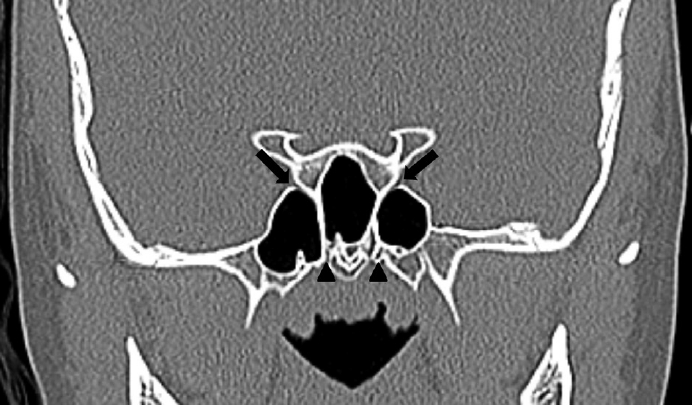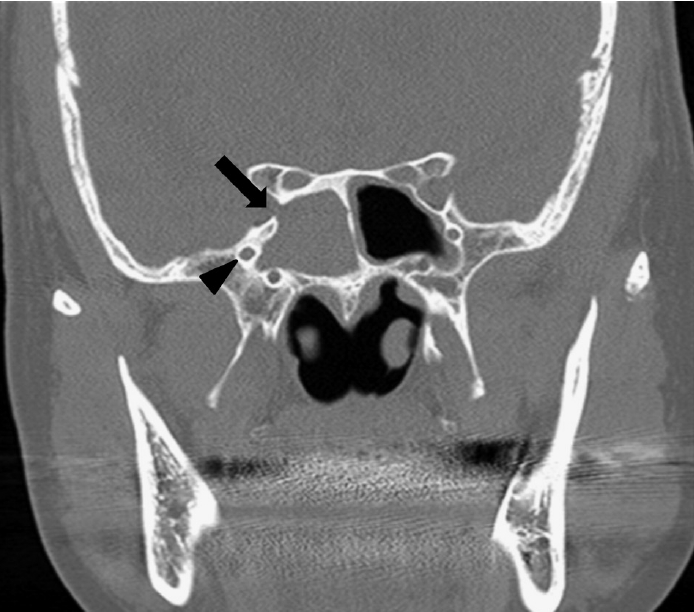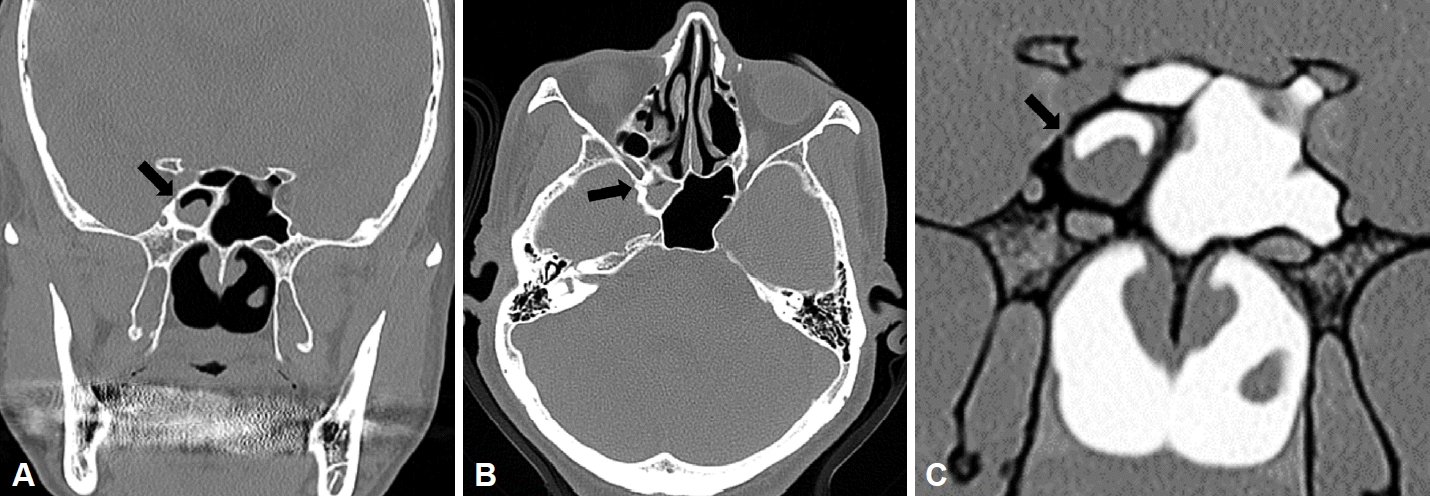1. Simmonds JC, Scott AR. Spontaneous CSF rhinorrhea from the trigeminal canal in an adolescent. Int J Pediatr Otorhinolaryngol. 2017; 98:162–5.
2. Illing E, Schlosser RJ, Palmer JN, Curé J, Fox N, Woodworth BA. Spontaneous sphenoid lateral recess cerebrospinal fluid leaks arise from intracranial hypertension, not Sternberg’s canal. Int Forum Allergy Rhinol. 2014; 4(3):246–50.
3. Settecase F, Harnsberger HR, Michel MA, Chapman P, Glastonbury CM. Spontaneous lateral sphenoid cephaloceles: anatomic factors contributing to pathogenesis and proposed classification. AJNR Am J Neuroradiol. 2014; 35(4):784–9.
4. Thakur JD, Manzi B, Savardekar AR, Singh MP, Menger R, Nanda A. Commentary: Maximilian Sternberg (1863-1934): the man behind Sternberg’s canal and his contribution to the modern-day skull base anatomy and neuroscience—historical vignette. Neurosurgery. 2018; 83(3):E120–4.
5. Barañano CF, Curé J, Palmer JN, Woodworth BA. Sternberg’s canal: fact or fiction? Am J Rhinol Allergy. 2009; 23(2):167–71.
6. Jung JH, Cho GS, Chung YS, Lee BJ. Clinical characteristics and outcome in patients with isolated sphenoid sinus aspergilloma. Auris Nasus Larynx. 2013; 40(2):189–93.
7. Meier JC, Scangas GA, Remenschneider AK, Sadow P, Chambers K, Dedmon M, et al. Skull base erosion and associated complications in sphenoid sinus fungal balls. Allergy Rhinol (Providence). 2016; 7(4):227–32.
8. Fokkens W, Desrosiers M, Harvey R, Hopkins C, Mullol J, Philpott C, et al. EPOS2020: development strategy and goals for the latest European position paper on rhinosinusitis. Rhinology. 2019; 57(3):162–8.
9. Cha H, Song Y, Bae YJ, Won TB, Kim JW, Cho SW, et al. Clinical characteristics other than intralesional hyperdensity may increase the preoperative diagnostic accuracy of maxillary sinus fungal ball. Clin Exp Otorhinolaryngol. 2020; 13(2):157–63.
10. Kim YS, Kim HJ, Kim CH, Kim J. CT and MR imaging findings of sinonasal schwannoma: a review of 12 cases. AJNR Am J Neuroradiol. 2013; 34(3):628–33.
11. Bhandarkar ND, Mace JC, Smith TL. The impact of osteitis on disease severity measures and quality of life outcomes in chronic rhinosinusitis. Int Forum Allergy Rhinol. 2011; 1(5):372–8.
12. Park JB, Cho YS, Choi HJ. Diagnostic accuracy of the inverted grayscale rib series for detection of rib fracture in minor chest trauma. Am J Emerg Med. 2015; 33(4):548–52.
13. Hopkins C, Browne JP, Slack R, Lund V, Brown P. The Lund-Mackay staging system for chronic rhinosinusitis: how is it used and what does it predict? Otolaryngol Head Neck Surg. 2007; 137(4):555–61.
14. Sethi N. The significance of osteitis in rhinosinusitis. Eur Arch Otorhinolaryngol. 2015; 272(4):821–6.
15. Seo MY, Seok H, Lee SH, Choi JE, Hong SD, Chung SK, et al. Microinvasive fungal rhinosinusitis: proposal of a new subtype in the classification. J Clin Med. 2020; 9(2):600.
16. Aribandi M, McCoy VA, Bazan C 3rd. Imaging features of invasive and noninvasive fungal sinusitis: a review. Radiographics. 2007; 27(5):1283–96.
17. Coop CA, England RW. Allergic fungal sinusitis presenting with proptosis and diplopia: a review of ophthalmologic complications and treatment. Allergy Asthma Proc. 2006; 27(1):72–6.
18. Deutsch PG, Whittaker J, Prasad S. Invasive and non-invasive fungal rhinosinusitis—a review and update of the evidence. Medicina (Kaunas). 2019; 55(7):319.
19. Schick B, Brors D, Prescher A. Sternberg’s canal--cause of congenital sphenoidal meningocele. Eur Arch Otorhinolaryngol. 2000; 257(8):430–2.
20. Giacchi RJ, Lebowitz RA, Yee HT, Light JP, Jacobs JB. Histopathologic evaluation of the ethmoid bone in chronic sinusitis. Am J Rhinol. 2001; 15(3):193–7.
21. Szolar D, Preidler K, Ranner G, Braun H, Kugler C, Wolf G, et al. The sphenoid sinus during childhood: establishment of normal developmental standards by MRI. Surg Radiol Anat. 1994; 16(2):193–8.
22. Shetty PG, Shroff MM, Fatterpekar GM, Sahani DV, Kirtane MV. A retrospective analysis of spontaneous sphenoid sinus fistula: MR and CT findings. AJNR Am J Neuroradiol. 2000; 21(2):337–42.
23. Choi YR, Kim JH, Min HS, Won JK, Kim HJ, Yoo RE, et al. Acute invasive fungal rhinosinusitis: MR imaging features and their impact on prognosis. Neuroradiology. 2018; 60(7):715–23.
24. Jun YJ, Shin JM, Lee JY, Baek BJ. Bony changes in a unilateral maxillary sinus fungal ball. J Craniofac Surg. 2018; 29(1):e44. –7.






 PDF
PDF Citation
Citation Print
Print





 XML Download
XML Download